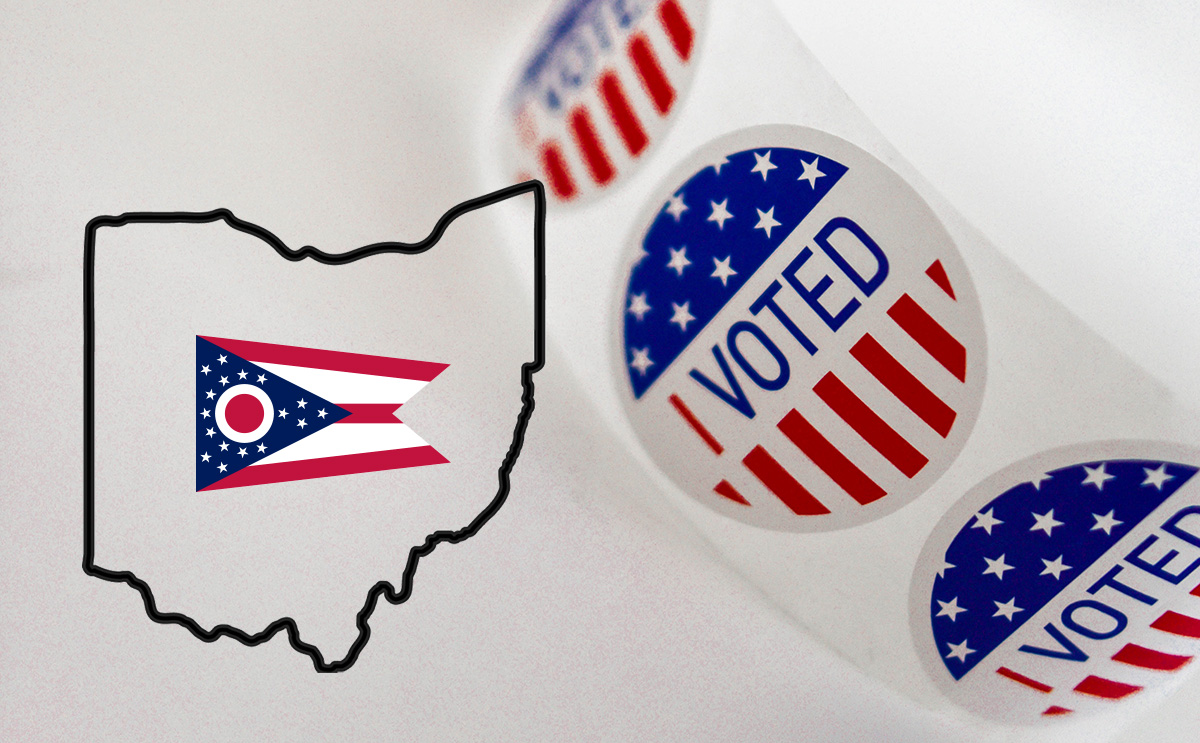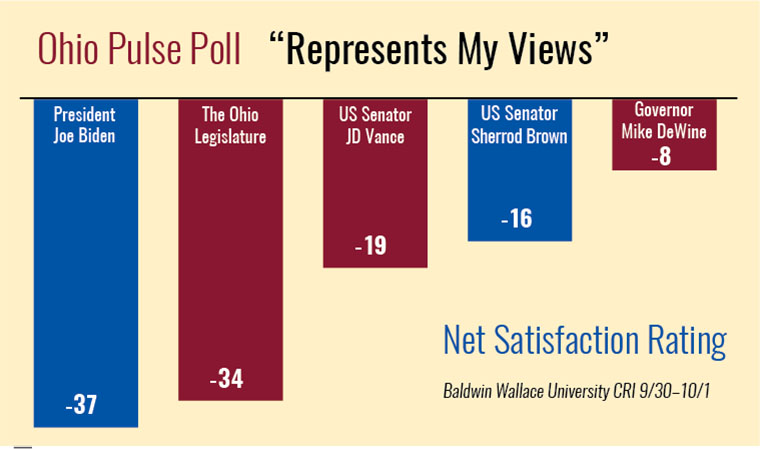The statewide survey underscores a disconnect between Ohio voters and the direction of their elected officials on critical issues.

A majority of voters in Baldwin Wallace University's new Ohio Pulse Poll say elected officials of all political stripes are falling short in representing their views.
Despite Ohio's reputation as a politically conservative state, the survey by BW's Community Research Institute (CRI) finds that Ohioans' views on a number of key issues — from gun control to education — are far more progressive than their statehouse leadership reflects.
The survey of 877 registered voters across Ohio, conducted from September 30 to October 1, highlights frustration with political leadership and a surprising alignment with some policies often seen as progressive, even as Ohio remains labeled a "red state."

All elected leaders received negative net ratings when participants were asked whether they were doing an excellent, good, fair or poor job representing their views.
President Joe Biden received the lowest score, at minus 37, but the Republican-dominated state legislature as a whole fared almost as poorly, at minus 34.
"Although Ohio's political leadership is leveraging conservative, wedge issues like illegal immigration and transgender rights in political advertising this election cycle, the Ohio electorate is more progressive on many other issues like education, gun restrictions and abortion," said Lauren Copeland, director of the CRI.
While inflation (24%) and the economy (18%) were identified as the most pressing issues for Ohio voters, survey results show stark differences between Ohio's voters and the direction of its elected officials on critical issues such as education, gun control, abortion and the public discourse around race and immigration.
Education: More than 80% support teaching lessons on the history and impact of race and racism in the U.S., and more than 60% back teaching sexual orientation in middle and high schools. Additionally, a majority of voters oppose parental control over which books are in the school library or the topics that are taught.
Gun Control: Despite Ohio's permissive gun laws, an overwhelming 86% of respondents favor expanded background checks for gun buyers aged 18 to 21, and 75% support raising the minimum age to buy an AR-15-style rifle from 18 to 21. Three-quarters of voters also support red flag laws, which allow the temporary removal of guns from individuals deemed dangerous. A ban on the sale of AR-15-style semi-automatic rifles also enjoys majority support (56%).
Reproductive Rights: 56% of Ohio voters say abortion should generally be permitted with some limitations, which is directly in line with the 56.8% of Ohioans who voted to enshrine reproductive rights in the state constitution last year.
Climate Change: Two-thirds of Ohio voters believe human activity is at least partially responsible for global climate change.
The survey also revealed conservative stances on hot-button issues often highlighted in GOP political ads.
Transgender rights: Large majorities of Ohio voters reject protections for transgender people. Nearly three-quarters oppose allowing transgender athletes to play on the team that matches their gender identity and object to medical professionals providing minors with medical care for a gender transition. Two-thirds of respondents take issue with transgender individuals using public bathrooms that match their gender identity.
Immigration: Opinions are more mixed on the issue of immigration, especially when it comes to illegals. Overall, voters are equally divided on whether to require undocumented immigrants to leave the country. Almost half believe illegal immigrants do not contribute to the U.S. economy, and some 58% of Ohioans say immigrants here illegally pose a significant or moderate threat to public safety.
However, on legal immigration, 60% of voters across the political spectrum agree with Governor Mike DeWine's call in a recent editorial for Ohioans to reject harmful rhetoric about legal Haitian immigrants in Springfield, Ohio, which "hurts the city and its people."
"The response to DeWine's editorial shows that Ohioans are capable of bipartisan consensus on immigration when the message is one of empathy and humanity," said Copeland. "It's a hopeful sign that voters across the board recognize the damage divisive rhetoric can cause and are willing to support a more humane approach."

With gerrymandering again on the November ballot, 69% of Ohio voters say they "strongly" or "somewhat" oppose the manipulation of electoral boundaries to give one political party an advantage.
Issue 1 would take the power to draw district lines away from elected politicians and establish a citizen's commission, but the final ballot language states, in part, that it would "require" gerrymandering.
"It remains to be seen if the level of antipathy toward gerrymandering translates to support for Issue 1 with the controversial wording of the final ballot language," said Copeland. "Rather than reflecting the intent of the amendment to establish a citizen-led independent redistricting process, the language is misleading. Elected politicians in Ohio from both parties have a long history of trying to hold onto the power that gerrymandering confers."
While one in ten (22% among liberals) cite "Threats to democracy" as an important issue in the upcoming election, voters overwhelmingly have confidence that Ohio can run a fair and accurate election this year.
Voters are split on the security of mail-in ballots, but majorities of all demographic subgroups believe the state can run a fair election on November 5, with 76% overall "very" or "somewhat" confident.
SurveyUSA administered the CRI survey instrument to 1,000 Ohio adults 09/30/2024 through 10/01/2024. Of the adults, 877 are registered to vote in Ohio and were asked the questions detailed in the Topline Report. This research was conducted online among a representative nonprobability sample of Ohio adults, selected at random by Lucid Holdings LLC of New Orleans. Adult respondents were weighted to US Census American Community Survey targets for gender, age, race, education and homeownership and to 2020 recalled Presidential vote.